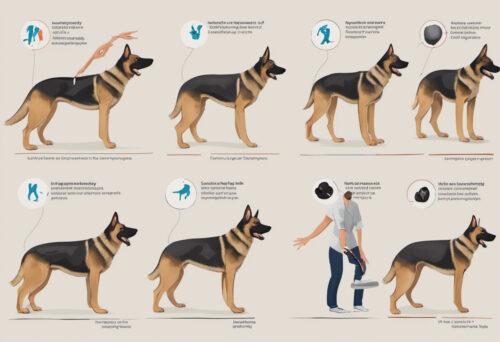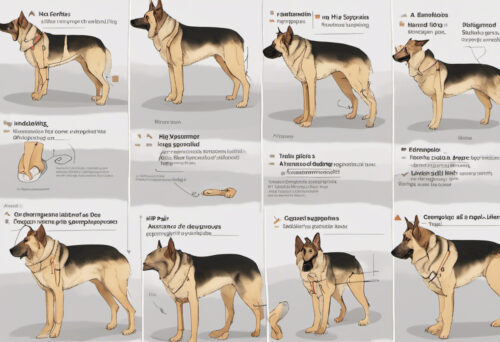For dog owners, one of the most incumbent responsibilities is to keep an eye on their furry companion’s health. One common health issue that many dogs face, particularly as they age, is hip dysplasia. This condition, involving an abnormal formation of the hip socket, can drastically affect a dog’s quality of life. Fortunately, with the right information and vigilance, it’s possible to detect hip dysplasia early, opening opportunities for effective treatment. By recognising key symptoms and signs, you can catch hip dysplasia in its early stages.
Understanding Hip Dysplasia in Dogs
Hip dysplasia is a genetic disorder, common in larger breeds like German Shepherds, Retrievers and Bulldogs, but it can technically occur in dogs of any size. The American Kennel Club explains it as a deformity of the hip joint that occurs during a dog’s growth period. This can eventually lead to painful arthritis or even crippling lameness. It’s crucial to understand that timely detection could mean the difference between a comfortable life and one filled with pain for your furry friend.
Spotting The Symptoms
Just like their human counterparts, dogs are good at hiding their pain. However, if you know what to look out for, you can spot the subtle signs of hip dysplasia. So let’s explore some common symptoms:
Altered Gait
Is Fido walking differently these days? Dogs with hip dysplasia often develop an altered or uneven gait. According to Cornell University College of Veterinary Medicine, they might sway, stumble or adopt a “bunny-hopping” gait where they use both hind legs simultaneously instead of one at a time.
Difficulty Rising
Dogs who are suffering from hip dysplasia may find it hard to get up from a sitting or lying down position. Keep an eye out as Purina suggests that struggling to rise can be an early warning sign of hip dysplasia.
Decreased Activity
One of the most heartbreaking signs of hip dysplasia is a reduction in your dog’s usual activity levels. Labradors may suddenly lose their enthusiasm for retrieving, and your tireless Collie might become reticent to romp around. According to Banfield Pet Hospital, decreased activity is often one of the key symptoms of this condition.
If you notice your dog exhibiting any of these behaviors or something else unusual, it’s crucial to schedule a visit with your vet, who can conduct a physical exam and imaging tests for a definitive diagnosis. Remember, early detection is pivotal in managing hip dysplasia.

Importance of Regular Vet Check-ups
Despite your best efforts to monitor your dog’s physical condition, it always pays to have regular veterinary check-ups. According to The American Veterinary Medical Association, routine vet exams can identify warning signs that owners might miss and are crucial for timely intervention in cases of hip dysplasia.
Management and Treatment
If your furry friend is diagnosed with hip dysplasia, it’s important not to panic. With proper treatment and management, dogs can lead comfortable lives. Blue Cross offers several suggestions to help manage hip dysplasia, from maintaining a healthy weight to providing physical therapy.
Medication
Non-steroidal anti-inflammatory drugs (NSAIDs) are commonly used to help manage pain and inflammation associated with hip dysplasia. PetMD explains how these medicines can make a huge difference in your dog’s comfort level. However, they need to be administered under careful veterinary supervision.
Surgery
In severe cases, surgical intervention might be necessary.Vets Now provides in-depth information on several surgical options, including total hip replacement and femoral head ostectomy. Your vet will be the best judge of the right surgical approach for your canine buddy.
Natural Remedies
Alongside conventional treatment methods, there are also several natural remedies such as hydrotherapy, acupuncture, and physiotherapy exercises. The Integrative Veterinary Care Journal provides a comprehensive look at some of these alternative therapy options.
Detecting hip dysplasia in your dog may be a daunting task, but remember you’re not alone in this journey. Reach out to veterinary professionals and communities for help and guidance. Armed with knowledge and support, you can ensure your furry friend lives a comfortable and happy life.

Reduced Enthusiasm for Physical Activity
If your agile Boxer starts displaying reluctance towards climbing the stairs or your playful Poodle seems to have lost interest in fetching games, they might be in pain. Rover lists reluctance towards physical activities as one of the subtle indications of hip dysplasia.
Taking Prompt Action
Recognizing these signs is the first step. The next – and equally important step – is to promptly consult a vet. There could be multiple reasons behind the symptoms, and misdiagnosis can lead to unnecessary worry. PubMed explains that veterinarians will usually perform a physical examination and recommend imaging tests to ascertain a diagnosis.
Living with Hip Dysplasia
A diagnosis of hip dysplasia doesn’t mean your best buddy can’t enjoy life. Depending on the severity of the condition, treatment may involve medication, surgery or weight management. PetFinder offers great advice on how to help your dog lead a fulfilling life after such a diagnosis.
Embracing A Healthy Diet & Exercise Regimen
A well-balanced diet and regular exercises can immensely benefit dogs with hip dysplasia. VCA Hospitals emphasizes the role of diet and exercise in maintaining optimal weight, which can reduce strain on your dog’s hips and alleviate discomfort.
Medications & Supplements
Certain medication and supplements can help combat the discomfort accompanying hip dysplasia. The American Kennel Club discusses how certain over-the-counter supplements can provide relief by reducing inflammation and promoting joint health.
Surgical Interventions
In extreme cases, your vet may suggest surgical procedures. The American College of Veterinary Surgeons outlines different surgical options, highlighting their potential benefits and risks. Discuss each option thoroughly with your vet to find a solution that suits your pooch the best.
Nobody wants to see their beloved pooch suffer, and early detection of hip dysplasia can pave the way for effective treatment avenues. If you observe any changes in your dog’s behaviour or mobility, treat it as a call to action and consult your vet immediately. Remember, with your love and vigilance, your canine companion can continue to lead a happy and active life.



